Introduction
The Nashville Pack Cutaway backpack (~14 ounces / 397 g, MSRP from $238), is a roll-top 30 liter (L) frameless pack with a modular shoulder strap attachment system. Customizable features include six available fabric selections and both J- and vest-style shoulder straps.
Frameless packs in this volume range are generally designed to carry loads of 20 Ibs (9 kg) or less. Heavier loads can be uncomfortable and painful in a frameless pack, especially for hikers who don’t have the shoulder and neck muscle conditioning to support the weight strain. While I enjoy the close fit and light weight of frameless packs, I usually use a framed pack when my loads go over that limit.
I ordered my Nashville Cutaway backpack with vest-style straps. I wanted to know if they increased comfort at loads over 20 lbs (9 kg) in comparison to the S- or J-style shoulder straps used on other frameless packs. If the Nashville Cutaway backpack with vest-style straps can support and stabilize heavier loads, then the pack could be more versatile than frameless packs with conventional shoulder straps. The additional weight-carrying capacity would allow it to be extended into colder seasons or for longer trips, where more gear and supplies are required.
Highlights
- five fabric options*: 210d Robic Nylon, VX07, 210d HDPE Gridstop, EPL 200 Ultra, 2.92 oz DCF Hybrid
- modular shoulder strap attachment system allows for multiple shoulder strap options
- option to purchase traditional J-style shoulder straps or hybrid vest-style shoulder straps
- shoulder straps and backpack are purchased separately
- shoulder straps incorporate several small pockets, aiding gear organization
- the overall final weight for a fully-featured pack is typically under 1 lb (454 g)
- comfortable at loads approaching 30 pounds
- quality craftsmanship (materials, cut and sew quality)
*My pack is made with Liteskin LS07, but as of this review’s initial release, this fabric is not currently offered as an option by Nashville Pack.
Review Context
The category of frameless packs with an internal capacity of 30-40 L plus exterior pockets includes several brands and models. Manufacturers of packs in this category include ULA Equipment, Mountain Laurel Designs, Gossamer Gear, Zpacks, and more than a dozen cottage gear makers. Most frameless backpacks can only carry a maximum total weight of ~20 lbs (9 kg) due to their lack of structure and inability to effectively transfer weight between the shoulder straps and hip belt. In the past few years, some manufacturers have begun adding vest-style harnesses to the category to help stabilize the load for runners, fastpackers, and hikers carrying heavier pack weights. For example, both Ultimate Direction and Mountainsmith offer larger (multi-day), ~40 L packs with vest-style harness systems.

My previous experience with 40 L frameless packs extends across several models. These include the Granite Gear Virga, the Mountain Laurel Designs Burn 38 L and Exodus, the ULA CDT, and a Zimmerbuilt Custom backpack. I also have experience with other frameless backpacks, both from smaller manufacturers and from MYOG projects.
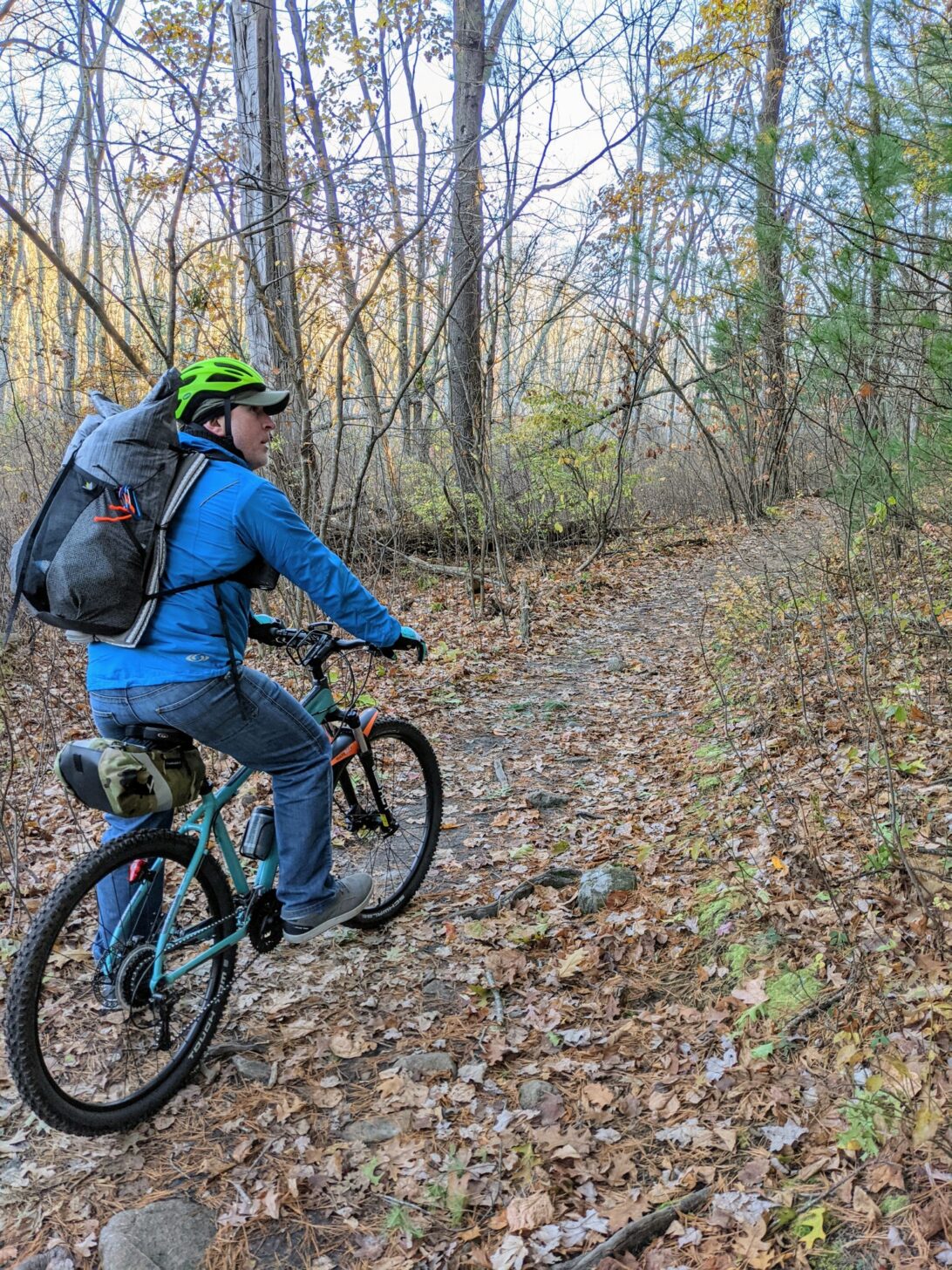
This is a Performance Review based on the long-term use of this pack in a variety of environments and in several different contexts. I used the Nashville Cutaway backpack for traveling, day hiking, backpacking, and bikepacking. Read more about our types of reviews here.
Features
- several customization options (shoulder straps, torso size, fabrics)
- two shoulder strap options, J- or vest-style
- shoulder straps are modular and interchangeable, so user can change the size and type easily
- three torso length sizes
- two shoulder strap sizes (J-style only)
- wrap around rear pocket, from back-panel seam to back-panel seam
- bottom pocket
- multiple shoulder strap pockets
- removable hipbelt
- exterior sleeping pad attachment system

The Nashville Pack Cutaway backpack loaded with 29 lbs (13.1 Kg).
Specifications
The Nashville Cutaway model reviewed here has the following specifications:
- fabric: Liteskin LS07
- torso length: 18 inch (45.7 cm) torso
- shoulder strap type: hybrid vest straps 17.5 in (44.5 cm)
- chest straps: one elastic and static chest strap
- hip belt: none
- total pack weight: 14.25 ounces (404 g)

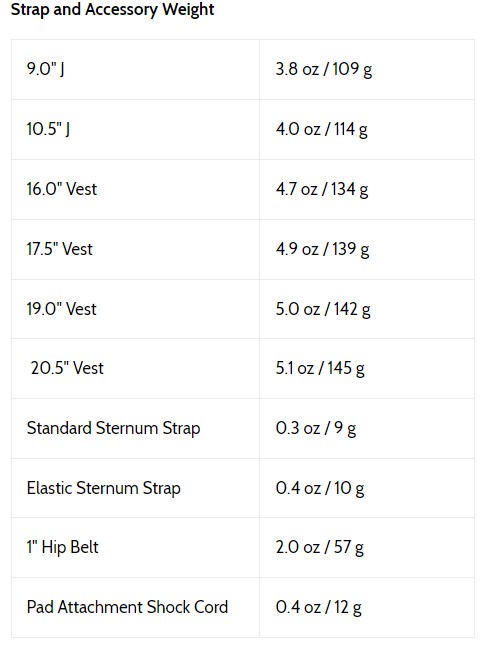
Description of Field Testing
I used the Nashville Pack Cutaway backpack as a multi-day backpacking pack, a large capacity daypack, and a carry-on backpack. In addition, I used it as a bikepacking backpack to supplement my frame bags.
I used the Nashville Cutaway backpack on a flight to Spain in August as my carry-on. I also used it as my day pack on a couple of hikes while there. Most of the trips took place in dry conditions in New Hampshire and Massachusetts during the late summer and fall. This review is based on my experience with the Cutaway over the course of 20 use days.
Performance Assessment
- load-carrying capacity with vest shoulder straps
- shoulder strap options and attachment
- fabric performance
- effectiveness of sleeping pad exterior attachment
- ability to extend volume
- usability of the elastic bottom pocket
- other observations
Load-Carrying Capacity with Vest Shoulder Straps
Often, I choose frameless packs in the 40 L range for short backpacking trips (or for all-day winter outings that require bulkier gear). They are also my travel carry-on luggage of choice. Even when using a foam pad as a virtual frame inside the bag, my comfort starts to suffer in the 18 to 22 lb (8 to 10 kg) range. For loads exceeding this range, I chose a framed pack.


I was particularly interested in testing the claim made by Nashville Pack that using the vest-style shoulder straps resulted in an increase in load-carrying capacity from 20 lbs (9 Kg) with J straps to 25 lbs (11.4 Kg) with vest straps.

A load-carrying capacity of 25 lbs (11.4 Kg) meant that I could pack enough gear for almost all of my three-season trips with the Nashville Pack Cutaway. I tested weight load-carrying capacity by starting at 20 lbs (9 kg) and adding a pound or so every trip. I was surprised that I could not reach a point where reasonable weight became uncomfortable. 25 lbs (11.4 Kg) proved to be a non-issue on daylong treks or overnighters.
Eventually, I overloaded this pack to its maximum volumetric capacity with 29 lbs (13.1 Kg) on a three-day, two-night trip (including some extra food) and I was surprised by how comfortable it carried the weight compared to my previous experience with frameless packs. The vest harness effectively distributes the load to help mitigate the effects of straining my shoulder and neck muscles.
Our daily mileage on this three-day, two-night family trip was about five miles per day. With frequent stops, it took us a little over four hours to reach our campsite. I didn’t take my pack off during our frequent rest breaks and other stops during our hike. I started feeling a bit of discomfort after three and a half hours, so I seized the opportunity to filter some water and take a ten-minute break from wearing the pack. Putting the pack back on, I had no additional soreness for the rest of that day (another 45 minutes to the campsite). For the next two days, the story was very similar.
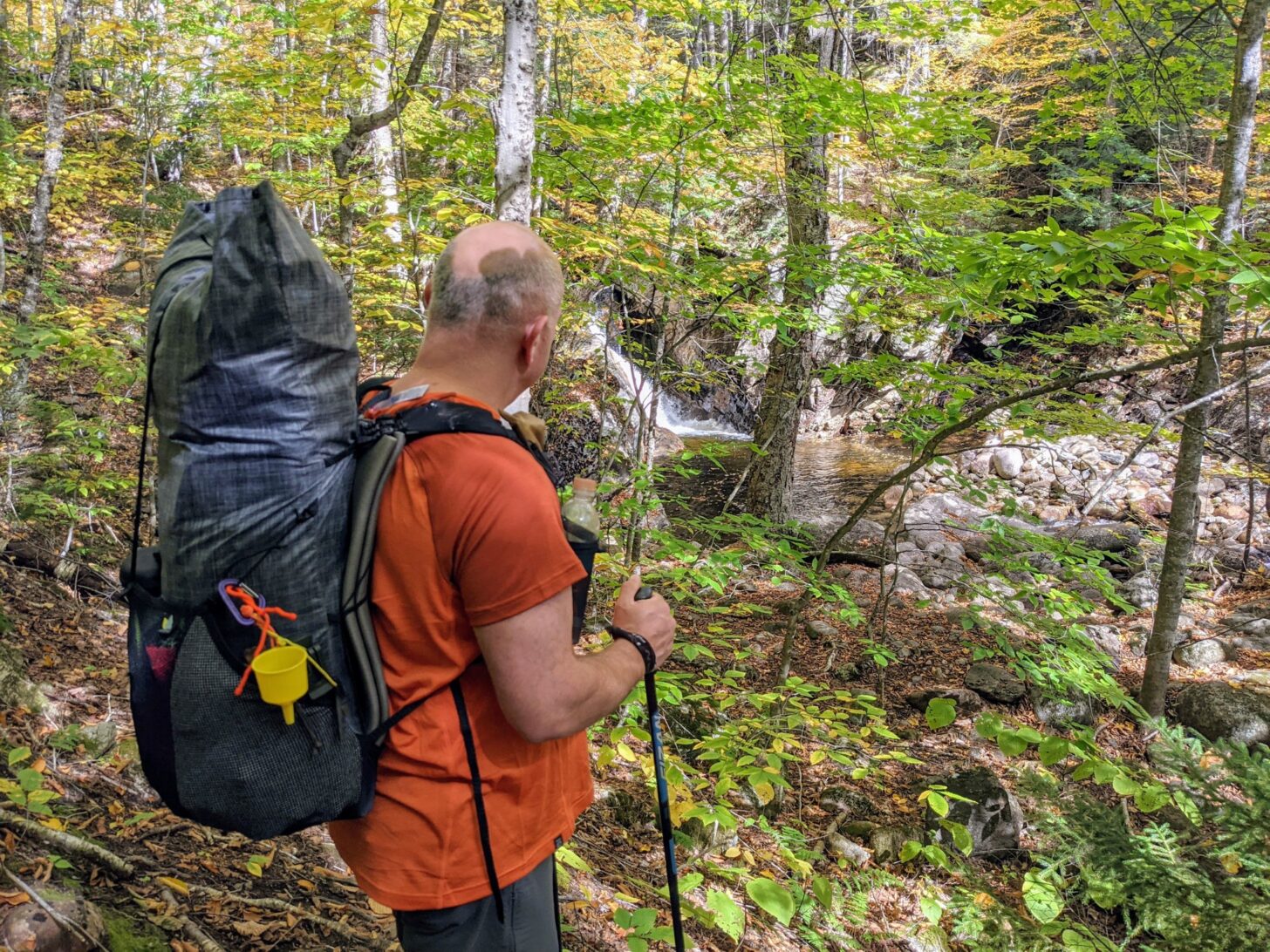
Shoulder Strap Options and Attachment
As previously mentioned, the shoulder straps and the backpack need to be purchased separately. The Nashville Pack website provides the necessary information about the Cutaway’s different torso sizes and shoulder strap styles. The straps themselves also come in different lengths. One needs to take the time to research this information presented before ordering to obtain the correct shoulder strap size. Some of the literature refers to videos that provide helpful visual assistance in understanding how the pack works.
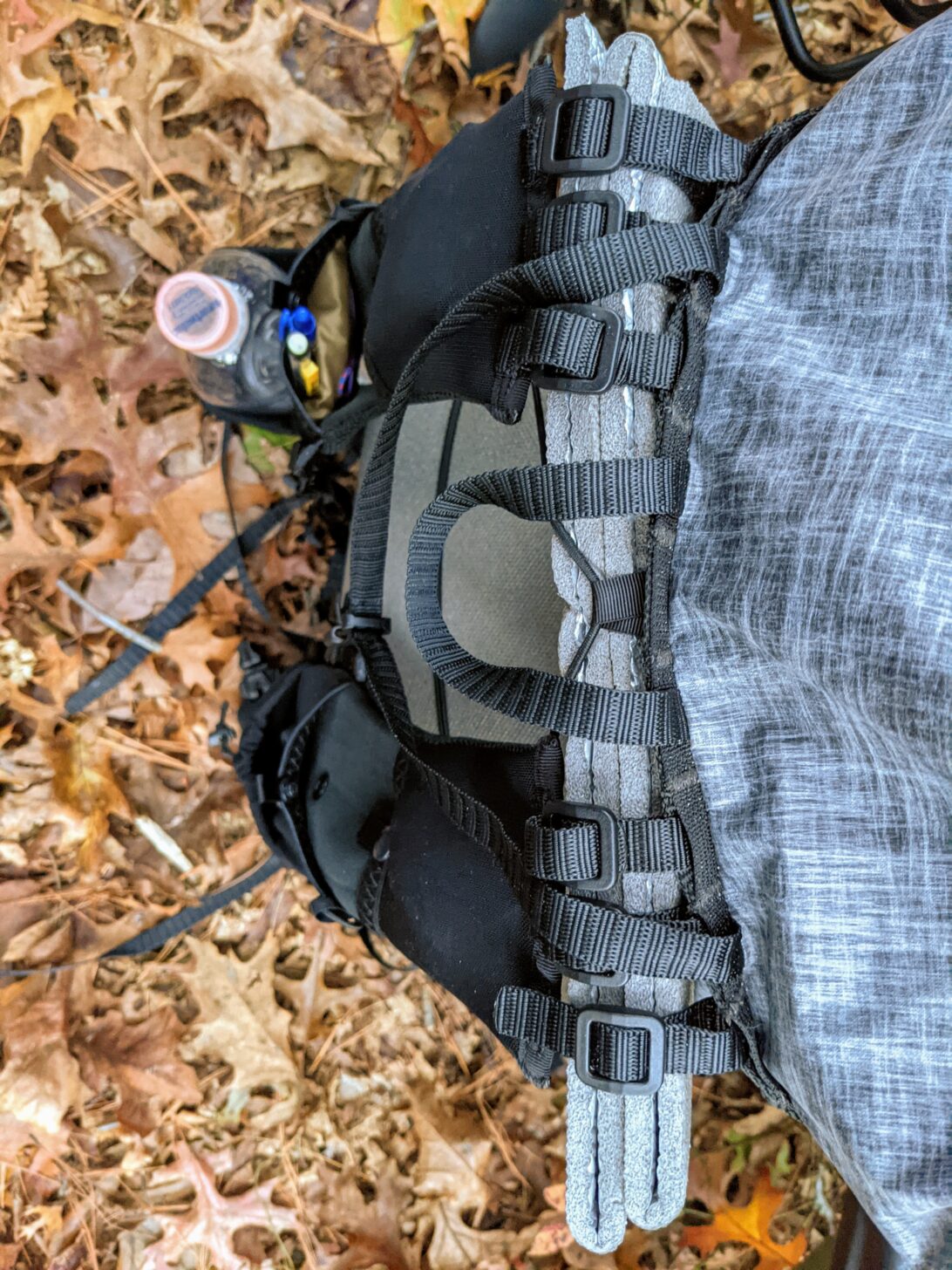
The top of a shoulder strap terminates with three pieces of webbing which are threaded through a daisy chain on the back panel and then through triglides on the shoulder straps.
In my opinion, this sort of interface has four distinct advantages.
First, this method of attaching the shoulder straps allows room for adjustment that makes it easier for the strap to conform to a hiker’s upper body shape. For example, one can adjust the length of the inside webbing so that it’s shorter, and the length of the outside webbing so that it’s longer, to accommodate wider, more athletic shoulders. The ability to adjust the angle of the shoulder straps could alleviate possible pressure points that create pain when carrying heavier loads in frameless packs. (Aside: I do wish the shoulder strap webbing pieces were an extra inch or two longer to give more versatility to this adjustment, especially when using a folded foam pad against the back panel.

The daisy chain into which the shoulder straps attach has four loops to accommodate three pieces of webbing. By having four daisy chain loops for each strap, the user can space the shoulder straps closer or farther apart from each other to accommodate different upper body shapes. For broad-shouldered hikers, it’s worth noting that the maximum distance at which the inside edges of the shoulder straps can be set is about 5.25 in (13.3 cm).
Second, one has the ability to extend the padded portion of the shoulder straps away from the backpack in order to fit a pad between the backpack and the user’s torso without having the shoulder straps loose padded length.
Third, damaged shoulder straps can be more easily replaced than those sewn directly into the backpack.
Finally, one can experiment with different sizes and styles of shoulder straps.
Fabric Performance: Liteskin LS07
Nashville Pack currently offers five fabric options for the Nashville Pack Cutaway:
- 210d Robic Nylon
- VX07
- 210d HDPE Gridstop
- EPL 200 Ultra
- 2.92 oz DCF Hybrid
My pack is made with Liteskin LS07, but this fabric is not currently available. This was my first pack made using Liteskin LS07. My initial impression is that it remains waterproof during steady light precipitation for at least a couple of hours. I suspect that prolonged abrasion of the pack fabric may affect its waterproof coating, as the fabric is relatively thin.
After about two dozen nights of trail use, I did notice that dirt and stains do not seem to stick to Liteskin LS07 the way they do to some pack materials. Moreover, the fabric pattern does not develop deep wrinkles, and the gray color I received hides the small ones well. Aesthetically, it’s a nice-looking pack fabric.
Effectiveness Of Sleeping Pad Exterior Attachment
Only the 20 inch (51 cm) torso size will fit a Z-Lite or similar 20-inch (51 cm) wide folding pad in the pad attachment straps. Shorter torso size Cutaway packs can fit sit pads or sleeping pads with trimmed widths.

The pack I received has an 18 inch (45.7 cm) torso size, but I was able to cram a 45 x 20 x 1/4 in (114.3 x 50.8 x 0.63 cm) pad in the pad attachment system. It was not a perfect fit. If one looks at the picture above, one can see the sleeping pad bulging just above the bottom stash pocket. Using a pad that’s wider than the torso length of the pack also makes accessing the stash pocket harder. In practice, however, using an oversized pad didn’t cause discomfort or create any other issues.

However, I agree with Nashville Pack when they say that untrimmed sleeping pads work only with the 20 inch (50.8 cm) torso sizes. I did try fitting a full-width Thermarest Z-Lite into my 18 inch (46 cm) torso size Cutaway, and the results were not satisfactory. Refer to the pictures below for additional details.

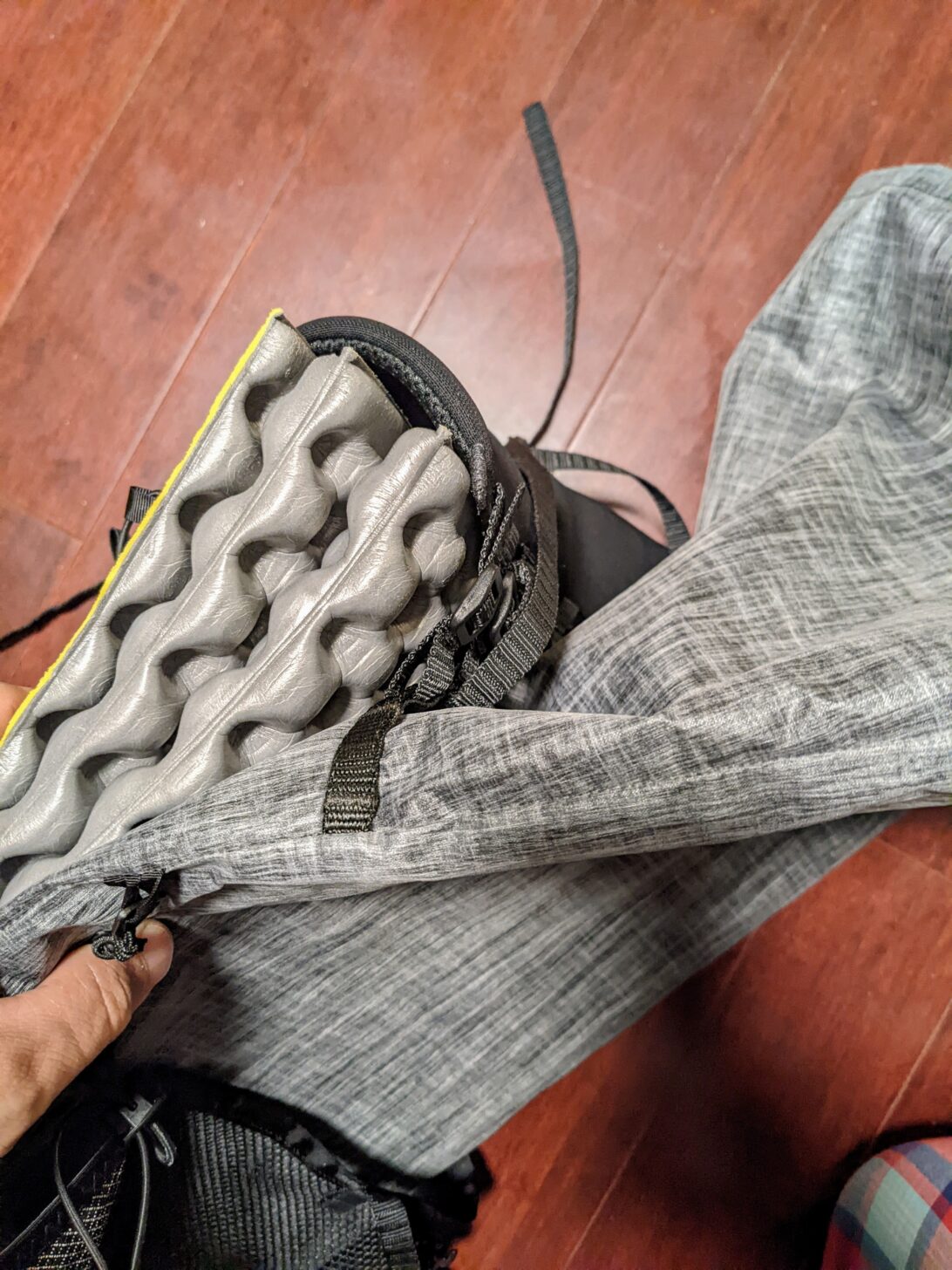

Ability To Extend Volume
The Nashville Pack Cutaway torso size specification corresponds to the distance from the bottom rear seam to the shoulder strap attachment point. In my case, I ordered the 18-inch (45.7 cm) torso size option. There is an extra 12 inches (30.5 cm) of pack height if you measure from the bottom rear seam to the very top of the extension collar. The main packbag is about 10 inches (25.4 cm) wide and about 5 inches (12.7 cm) deep. This is a rather trim bag that seems to match the 25 L advertised volume. Using the extension collar and wrap-around pocket (in addition to the pockets in the shoulder straps) extends the capacity to the advertised 40 L.
Four large pockets and two small pockets are sewn into the vest shoulder harness. The large pockets can accommodate tall, thin bottles.

The Nashville Pack Cutaway is the first pack I have ever owned with a full wrap-around rear pocket, i.e., there is no seam separating the rear pocket from what we normally consider as side pockets (i.e., water bottle pockets). I was worried things would move around and perhaps even fall through the lower water bottle pocket area into the rear pocket, but in practice, this was not an issue. There is a shock cord that tightens the rear pocket, and this both adjusts volume and keeps the pocket tight against the main compartment.
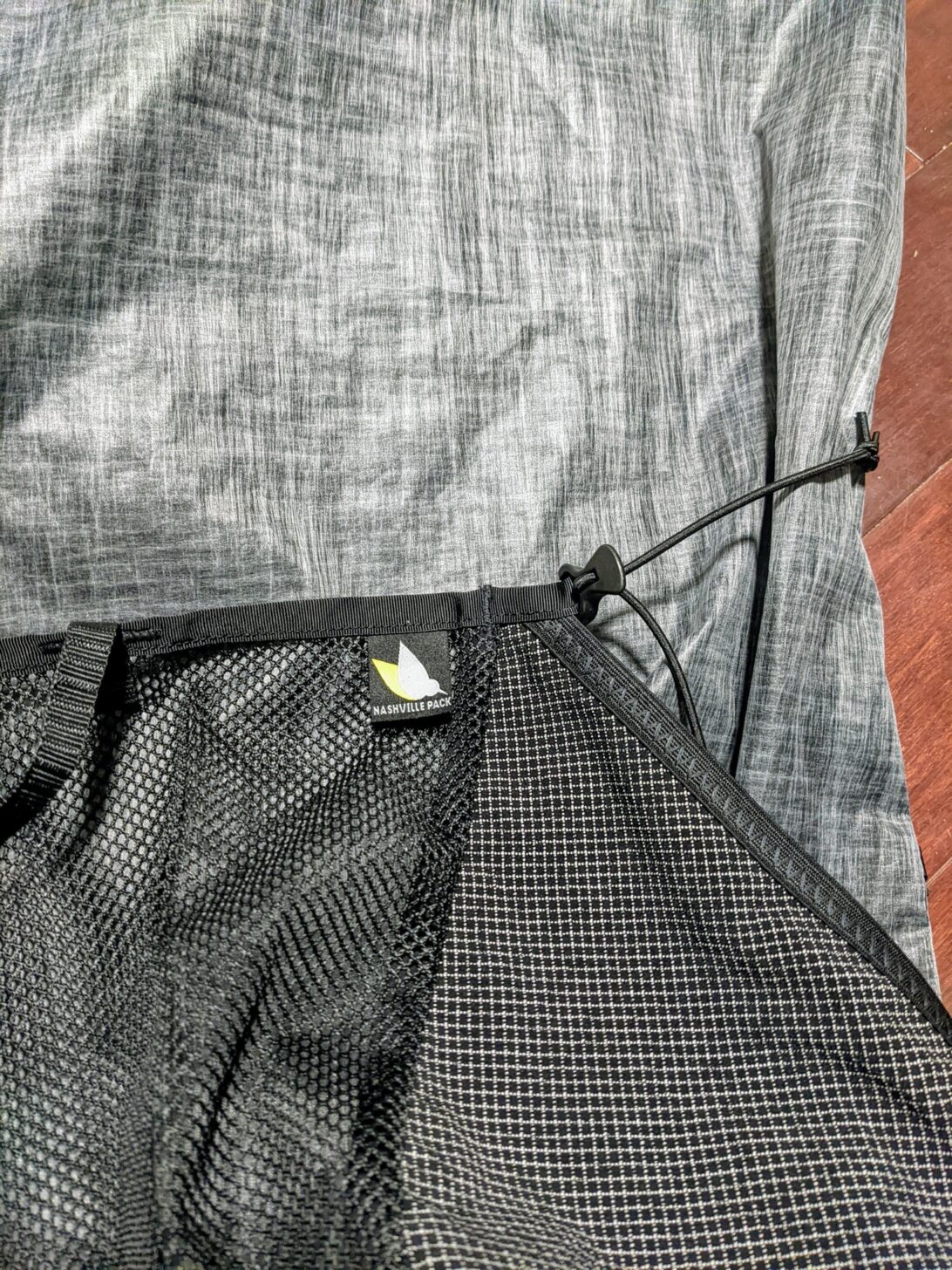
One improvement to the Nashville Pack Cutaway would be adding adjustability to the loop (“Y”) side of the top compression strap. When the pack is overloaded and the extension collar is full, the Y strap is a bit short, reaching only about 3/4 of the way up the length of the extension collar (see photo, below).
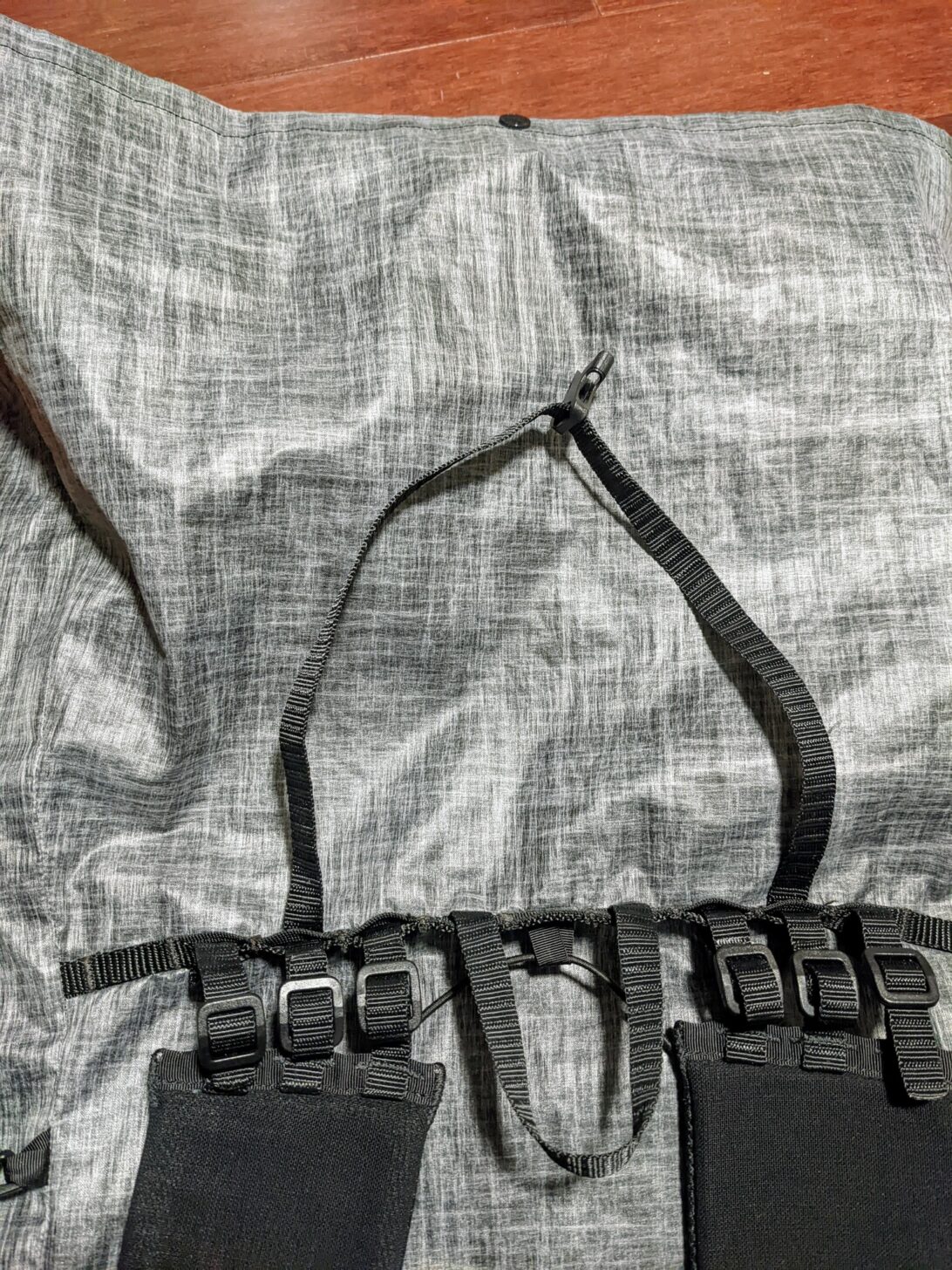
This limited length is fine if the pack is not overloaded. But if you’re. using the extension collar, compression would benefit from a longer Y strap. One option would be to redesign the Y strap to be adjustable in length based on how much of the extension collar is in use. This is the strategy used in similar Y-strap configurations (e.g., Hyperlite Mountain Gear).
Otherwise, the other end of the strap is long enough to reach over the extension collar.

Usability of the Bottom (Stash) Pocket
The Nashville Pack Cutaway is the first backpack I have ever owned with a bottom pocket (commonly known as a stash pocket). I initially questioned its usability, as I was afraid that things would fall out of it. This has not been the case because the pocket is made from a stretchy fabric and is sewn flat against the bottom of the pack.
As I stuffed more bits of gear in there, the stash pocket just seemed to swallow them without issue. Most bottom stash pockets I have seen are accessed from the sides, which means that if there is only one opening for the hiker to access gear. In contrast, the bottom pocket in the Cutaway is accessed from the hiker’s back side, which means that you can place things towards the sides or middle as needed and access them more easily. I find the bottom pocket is a natural place to stash gloves, neck gaiters, and snacks while on the move.
I was not expecting the lightweight Lycra pocket to last very long against New England’s highly-crystalline granite. But I’ve been mindful of putting the pack down gently and have not subjected it to very much abrasion. It is still holding up well after on-trail use.
Other Observations
The Nashville Pack Cutaway comes in three different torso sizes. The torso length refers to the distance from the shoulder strap attachment point to the base of the pack. My pack has an 18 inch (45.7 cm) torso size, while I have an 18.5 in (47 cm) torso (as measured from the protruding cervical vertebrae at the base of my neck. to the top of my iliac crest). Nashville Pack recommends sizing down from one’s torso size if not using a hip belt if you to keep the pack clear of the butt and torso. However, if you are between sizes and using a hip belt, Nashville Pack recommends sizing up.
I am happy with my choice, as I do not typically use a hip belt with frameless packs and I wanted to keep it away from my lower back. My first impression when trying the pack loaded was that it rode a bit high and I was worried about it being tippy. However, in practice, the pack (at least when used with a vest harness) is stable even with a load that results in a fully-extended extension collar. Such is a benefit of a small-volume backpack.

When I first put on the pack, I noticed that there was a point or two of stitching at the bottom of the chest strap daisy chain on the shoulder straps that seemed sharp and abrasive. I was worried that it would start destroying my lightweight wool t-shirt. The abrasive point(s) softened with use after a few hours of trekking and no damage ever occurred to my shirt.
The craftsmanship of the pack is excellent. The only comment I received from friends looking at the pack regarding build quality has to do with the lack of edge binding tape (or seam taping) on the interior seams. This may be a way to cut costs, but is unusual for a pack in this price range. (Personally, it does not bother me.) I sort of like seeing the seams, as I can see if there are problems more easily.
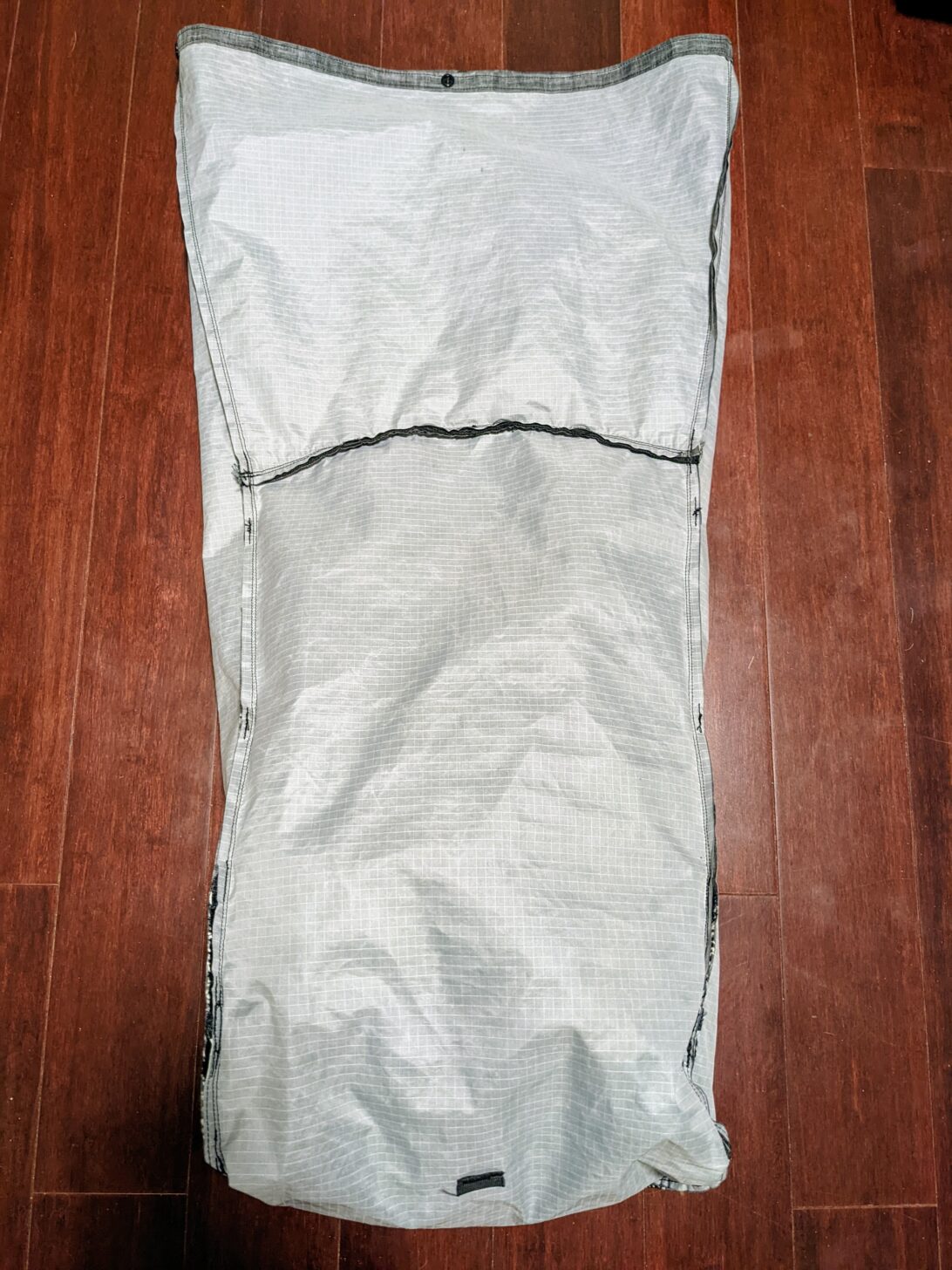
You may have noticed in previous pictures that most of the nylon webbing that comes with the pack is quite long. I have not trimmed any of the straps (yet). For example, the static chest strap is 18 inches (45.7 cm) long, and the elastic one is only slightly shorter. The webbing at the bottom of the shoulder strap is 25 inches (63.5 cm) long. Nashville Pack ships its packs with intentionally long webbing to allow users to trim any excess to their own specifications.
However, the top webbing on the vest harness that connects to the pack’s back-panel daisy chain are – in my opinion – too short. I fear that if one places an accordioned pad against the back panel, the shoulder straps will see their length shortened.
Commentary
The Nashville Pack Cutaway has become my favorite backpack for day hiking and shorter overnight trips. It is a 25 L pack (main packbag volume) that has the ability to swallow up to 15 L of additional gear into its external pockets.
I love the multitude of pockets on the Cutaway. I agree with the idea that the less we carry, the more we will enjoy the experience since we will have fewer things to pack and unpack and keep track of. However, I still seem to end up with a long list of items to pack and manage on backpacking trips.
In the past, I used color-coded stuff sacks to organize gear: Red for food, orange for creams and lotions, blue for small garment accessories, grey for hygiene products, white for extra batteries and flashlights, etc. The multitude of pockets on the Nashville Cutaway (including those on the vest-style shoulder straps) simplifies packing for me. Instead of having to remove three stuff sacks from my pack to find the things I need, my gear can live in dedicated pockets. And now, these items are available on the go and more easily accessible while hiking.
Bonus Mini-Review – Nashville Pack Tiempo and Vest-style Shoulder Straps
Andrew Marshall here. In doing my initial research into the Nashville Pack Cutaway before assigning it to Iago for review, I came across the Nashville Pack Tiempo backpack. The Tiempo is a 17 L (when fully expanded) fastpack/daypack that also uses Nashville Pack’s modular shoulder-strap system.
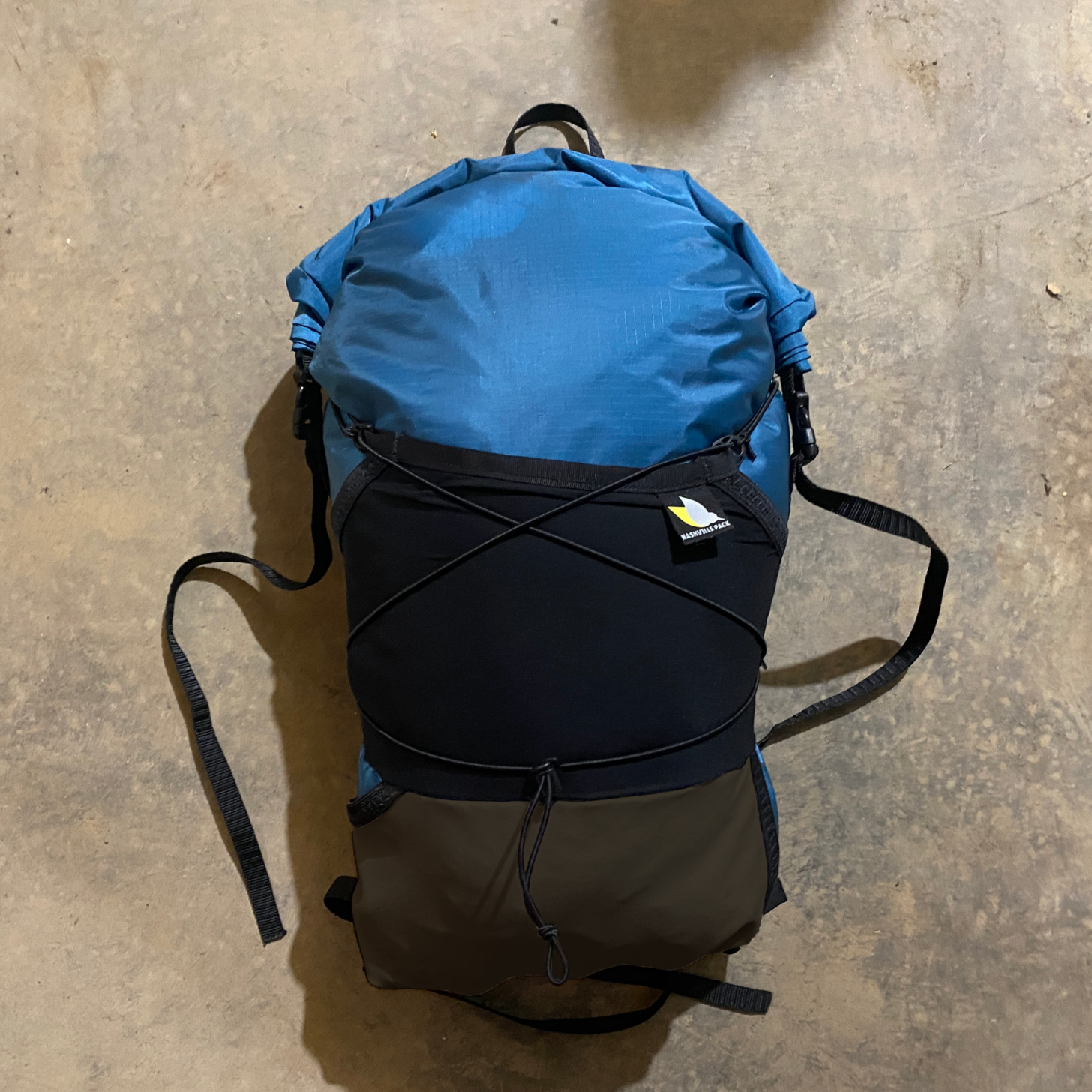
My original intention was to provide a separate review of the Tiempo based on some fastpacking in my home range of the Sierra Nevada over the summer of 2021. However, our horrendous wildfire season and corresponding worst-in-the-world air quality canceled those plans. I was, however, able to use the Tiempo on long (20+ mile) trail runs in the fall of 2021. I ordered my Tiempo with the same vest-style straps that Iago tested, and so I am able to offer my thoughts on that system.
- I love the three-point webbing connection between the shoulder straps and the pack body. I agree with Iago that it offers a high degree of custom-fit, flexibility, and comfort. I also agree with Iago that I wish this webbing was a little longer to offer even more options.
- The lower pockets on the vest-style straps are well-designed and spacious enough for the types of water bottles ultralight backpackers prefer.
- I’ve used a lot of running packs and the Tiempo is one of the most stable – if not the most stable – I’ve ever tested (for its volume). I can imagine that most of this is coming from the well-designed shoulder straps. I can also imagine how this might translate to superior load transfer and stability in a larger pack.
- I also noticed the sharp edge on the lower corner of the nylon webbing that runs along the inside edge of the vest-style shoulder strap. On one run in particular – early in my testing period – this edge poked a hole in my merino wool shirt. I fiddled around with the strap attachment webbing after my run and never had the issue again.
Compared To…
Weight and volume (capacity) comparisons between the Nashville Pack Cutaway and another lightweight, small-volume frameless packs are commonplace. A more fair comparison might be to compare the Nashville Cutaway backpack to other packs with vest-style harnesses, i.e., the Yar Gear Drifter 38L, Minimul 35, and the Yama Mountain Gear Sassafras Fastpack. However, even these comparisons are a little misguided for two reasons.
First, while the straps on the vest harnesses of the aforementioned packsare a little wider than most standard J-style shoulder straps, they still don’t have the width found on the Nashville Cutaway or many running vests from mainstream manufacturers.

Second and more important, the straps on the Nashville Pack Cutaway are unpadded (other than some very thin 3D mesh), unlike those of the aforementioned packs. When discussing load-carrying comfort and the vest shoulder harness, the Nashville Cutaway might best be compared to the Six Moon Designs Flight 30, the Salomon XA 35, or the Ultimate Direction Fastpack 30 (and other such low-volume packs that mostly lack padding on their shoulder straps). The Flight harness has padding only at the top of the shoulders. I do not have experience with the other two packs. The XA 35 seems to have padding at the top of the shoulders as well, whereas the Fastpack seems to be fully unpadded.
As soon as you don a Nashville Pack Cutaway or Six Moon Designs pack with a vest harness, you can feel right away how the wide, unpadded straps conform to the body. It practically hugs your thorax. It is almost more like wearing a garment than a traditional backpack. As I mentioned in my discussion of the Nashville Cutaway vest shoulder straps above, this capacity to conform to the upper torso seems to be the secret to its comfort, stability, and the increased load-carrying capacity.
When looking at the table below, the Nashville Pack Cutaway stands out as the only pack weighing less than one pound (0.45 kg) with a wide unpadded running vest style harness when compared to the other packs in this list.
| internal volume | total volume | weight | dimensions | torso sizes | fabric options | shoulder strap options | MSRP | |
|---|---|---|---|---|---|---|---|---|
| Nashville Pack Cutaway | 31 L | 40 L | Approx 14 oz (397 g) | 11.5 x 5.5 x 30 in (29.2 x 14 x 76.2 cm) | 3 | 6 | 2 | Starts at $259 |
| Yar Drifter 38 L | 30 L | 38 L | Approx 14 oz (397 g) | 11 x 5 x 32 in (28 x 12.7 x 81.3 cm) | 2 | 4+ | 2 | Starts at $210 |
| Minimul 35 | 30 L | 38 L | 14 oz (397 g) | 9-12 x 6 x 30 in (22.9-30.5 x 15.2 x 76.2 cm) | 5 | 1 | 1 style 2 lengths | Starts at $166 |
| Yama Mountain Gear Sassafras Fastpack | 26+ L | 34 L | 18.9 oz for the packbag (536 g) or 22.3 oz (632 g) with hipbelt | Not published | 3 + custom | 2 | 1 | $265 |
| Six Moon Designs Flight 30 Ultra | 27 L | 31 L | Starts at 19.7 oz (561 g) and up depending on fabric options and whether or not one wears a hipbelt | 11 x 7 x 17 in (28 x 17.8 x 43 cm) (not including extension collar) | Adjustable 16-22 in (38-56 cm) | 2 | 3 | Starts at $200 |
| Salomon XA 35 | 30 L | n/a | 21.3 oz (603 g) | 16.5 x 0.4 x 19.7 in (42 x 1 x 50 cm) (there seems to be an error with the published dimensions) | 2 | 1 | 1 | $210 |
| Ultimate Direction Fastpack 30 | 31.7 L | n/a | 1.52 lbs (690 g) | 11 x 7.4 x 19 in (27.9 x 18.7 x 48.3 cm) (not including extension collar) | 2 | 1 | 1 | $180.00 |

Strengths
- increased load-carrying capacity and stability with vest-style shoulder harness when compared to standard J- or S-style shoulder straps
- easily accessible pockets aid organization
- option to adjust the angle at which the shoulder straps exit the pack body makes it adaptable to a wider range of body types
- seamless transition between a 25 L pack and a 40 L pack, thanks to pocket configuration and the expandable capacity of the rear, wrap-around pocket
- clean aesthetics, once the long straps are trimmed
- high level of craftsmanship
Limitations
For a frameless pack that can comfortably carry this much weight, I would like to see an option to add a (small) bear canister to the mix. Perhaps a four-point mesh harness could be secured to the pack’s back panel. Load-carrying stability might be compromised, of course, but we have few options when dealing with such small packs.

Who Should Consider This Pack
The Nashville Pack Cutaway may be a good choice for those frameless pack users that occasionally need to carry more than 20 lbs (9 Kg) of gear without too much suffering.
The Cutaway should also be considered for those who value external access to a variety of things during the course of the day and wish to keep them compartmentalized and easily accessible.
Who Should Not Consider This Pack
While I found the Nashville Pack Cutaway comfortable carrying 29 lbs (13.1 kg), I am hesitant to recommend it to users who regularly carry more than 25 lbs (11.3 kg), or to users who are otherwise not accustomed to carrying heavy loads in frameless packs.
Anyone who needs easy external storage of bear canisters should look elsewhere.
Recommendations For Improvement
- I would like to see a bear canister carry option, perhaps in the form of a system that can be integrated with the top strap or can be attached to the rear panel.
- Increase the length of the attachment webbing at the top of the shoulder straps by one or two inches (2.54 or 5.08 cm)
- The website could benefit from more effective visual aids describing the pack options and features to minimize the shopping effort required to make a purchasing decision.
- The Y-strap seems to be a good length as long as the pack is not overloaded, reaching about 3/4 of the way up the extension collar. But users that regularly stuff their pack to its full capacity would probably like to see a longer Y-strap that reaches over the top of the fully-extended collar. Of course, this would require the Y-strap to be adjustable so it would not be too long when the pack is less full.
Review Rating
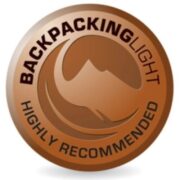
The Nashville Pack Cutaway deserves a Highly Recommended rating based on its carry comfort at higher loads for a frameless backpack, quality craftsmanship, and ability to transition from a daypack to an overnight pack because of its small base volume and large expandable pocket volume).
Summary
I began this review wondering if the Cutaway could transcend the typical load-carrying capacity of a 30 L frameless pack (~20 lbs / 9 kg). After extensive use, I’m happy to report that I was able to increase the comfortable load of the Cutaway backpack up to 29 lbs (14 kg). I ran out of usable volume before I ran out of load-carrying capacity. That means the Nashville Pack Cutaway is more useful in a variety of use-cases than most of the similar frameless packs I’ve tested.
The modular shoulder-strap attachment system and comfortable vest-style shoulder straps with plentiful pockets are standout features, as are the wraparound rear pocket and simple-but-functional pad attachment system. These are all the reasons I also recommended the Nashville Pack Cutaway backpack as one of my 2021 Staff Picks.
Learn More
Browse our curated recommendations in the Backpacking Light Gear Shop – a product research & discovery tool where you can find Member gear reviews, Gear Swap (used gear) listings, and more info about specific products recommended by our staff and members.
Gear Shop » Frameless Backpacks
Related Content
- more by Iago Vazquez
- read more Backpacking Light Gear Reviews
- if you are new to the sport and overwhelmed by pack options, check out our updated Ultralight Backpacking Boot Camp so you can learn about how to choose and use a backpack
DISCLOSURE (Updated April 9, 2024)
- Product mentions in this article are made by the author with no compensation in return. In addition, Backpacking Light does not accept compensation or donated/discounted products in exchange for product mentions or placements in editorial coverage.
- Some (but not all) of the links in this review may be affiliate links. If you click on one of these links and visit one of our affiliate partners (usually a retailer site), and subsequently place an order with that retailer, we receive a commission on your entire order, which varies between 3% and 15% of the purchase price. Affiliate commissions represent less than 15% of Backpacking Light's gross revenue. More than 70% of our revenue comes from Membership Fees. So if you'd really like to support our work, don't buy gear you don't need - support our consumer advocacy work and become a Member instead.
- Learn more about affiliate commissions, influencer marketing, and our consumer advocacy work by reading our article Stop wasting money on gear.





Home › Forums › Nashville Pack Cutaway Review